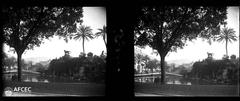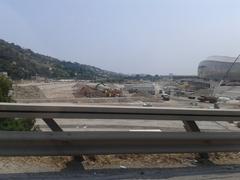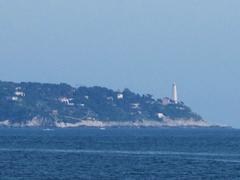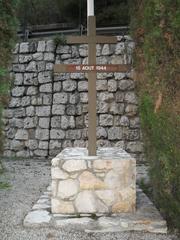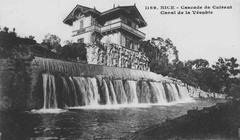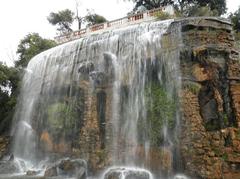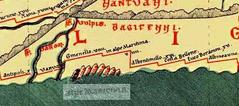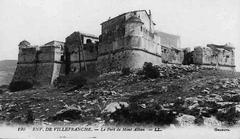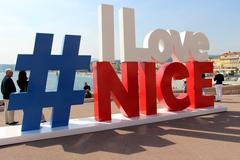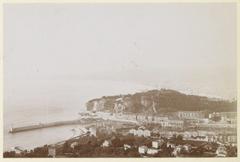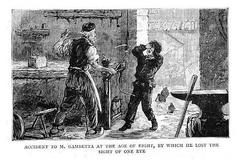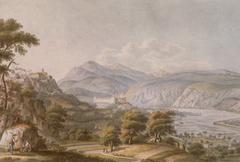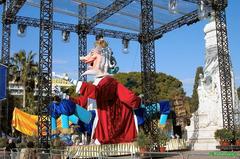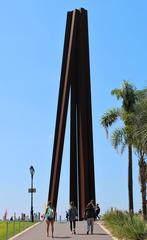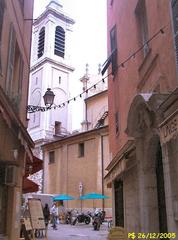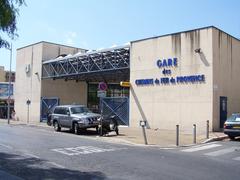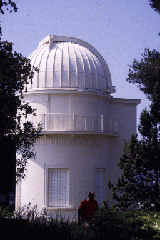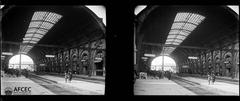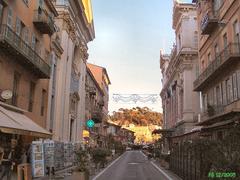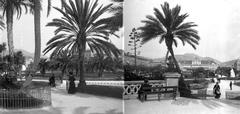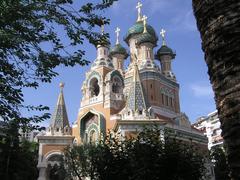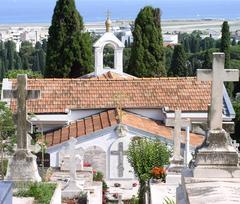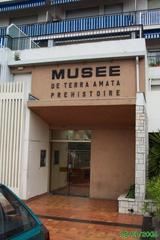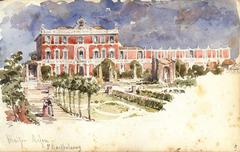Visiting Pyramide de Falicon: Hours, Tickets, and Travel Tips
Date: 01/08/2024
Introduction
Nestled near Nice on the picturesque French Riviera, the Pyramide de Falicon stands as a unique historical monument that has captivated the curiosity of historians and tourists alike. This pyramid, located atop the Ratapignata Cave, also known as the ‘Cave of the Bats,’ dates back to the early 19th century and is shrouded in mystery and intrigue. Discovered in 1803 by Domenico Rossetti, the pyramid’s origins are linked to the Napoleonic Era, a period characterized by a profound fascination with Egyptian culture, known as Egyptomania (Trip.com). Over two centuries later, in October 2007, the Pyramide de Falicon and the Ratapignata Grotto were officially recognized as historical monuments, underscoring their cultural and historical significance (Happily Ever Travels). This guide will delve into the rich history of the Pyramide de Falicon, provide practical travel tips, and highlight nearby attractions to ensure an enriching visit.
Table of Contents
- [Historical Background](#historical-backgroundhistorical-background)
- [Discovery and Early Documentation](#discovery-and-early-documentationdiscovery-and-early-documentation)
- [Theories of Origin and Construction](#theories-of-origin-and-constructiontheories-of-origin-and-construction)
- [Historical Significance](#historical-significancehistorical-significance)
- [Recognition as a Historical Monument](#recognition-as-a-historical-monumentrecognition-as-a-historical-monument)
- [Unique European Pyramid](#unique-european-pyramidunique-european-pyramid)
- [Connection to Egyptomania](#connection-to-egyptomaniaconnection-to-egyptomania)
- [Modern-Day Significance](#modern-day-significancemodern-day-significance)
- [Visiting the Pyramide de Falicon](#visiting-the-pyramide-de-faliconvisiting-the-pyramide-de-falicon)
- [How to Get There](#how-to-get-therehow-to-get-there)
- [Tickets and Visiting Hours](#tickets-and-visiting-hourstickets-and-visiting-hours)
- [Travel Tips](#travel-tipstravel-tips)
- [Nearby Attractions](#nearby-attractionsnearby-attractions)
- [Frequently Asked Questions](#frequently-asked-questionsfrequently-asked-questions)
- [Is the Pyramide de Falicon accessible year-round?](#is-the-pyramide-de-falicon-accessible-year-roundis-the-pyramide-de-falicon-accessible-year-round)
- [Are there guided tours available?](#are-there-guided-tours-availableare-there-guided-tours-available)
- [What should I bring for my visit?](#what-should-i-bring-for-my-visitwhat-should-i-bring-for-my-visit)
- [Conclusion](#conclusionconclusion)
- [Call to Action](#call-to-actioncall-to-action)
Historical Background
Discovery and Early Documentation
The story of the Pyramide de Falicon begins in 1803 when Domenico Rossetti discovered the Ratapignata Cave, also known as the ‘Cave of the Bats’. Rossetti’s discovery inspired him to write a poem celebrating the cave in 1804, likely leading to the pyramid’s construction in the following years. The earliest clear documentation of the pyramid dates back to 1814, suggesting it was built between 1803 and 1812 during the Napoleonic Era.
Theories of Origin and Construction
The origins and purpose of the Pyramide de Falicon remain somewhat mysterious, with various theories proposed over the years. One theory suggests Roman legionaries built the pyramid as part of Egyptian cult practices. However, recent evidence points to a construction date between 1803 and 1812, aligning with the heightened interest in Egypt following the French campaign in Egypt and Syria. Other theories propose that the pyramid marks the tomb of an ancient chieftain or serves as a temple to the Persian goddess Mithra. There is also speculation that the Templars might be linked to the pyramid’s construction, but no evidence supports this claim.
Historical Significance
The Pyramide de Falicon and the Ratapignata Cave hold significant historical importance. The cave’s entrance, topped by the pyramid, faces southeast. Inside the cave, a pillar formed by a stalagmite and stalactite meets, creating a natural wonder that has fascinated visitors for centuries. Despite its partial ruin, the pyramid stands as a testament to historical fascination and mystery.
Recognition as a Historical Monument
In October 2007, over two centuries after its discovery, the Ratapignata Grotto and the Pyramide de Falicon were officially recognized as historical monuments. This recognition highlights the site’s historical and cultural significance, ensuring its preservation for future generations.
Unique European Pyramid
The Pyramide de Falicon is one of the very few pyramids in Europe, making it a notable site. Built over the opening of the Grotto of Ratapignata, it adds to the site’s uniqueness. The grotto beneath the pyramid, called Bauma des Ratapignata in Occitan, or ‘Cave of the Bats,’ enhances the mystery. The combination of history, geology, and mystery makes the Pyramide de Falicon a truly intriguing site.
Connection to Egyptomania
The construction of the Pyramide de Falicon during the Napoleonic Era aligns with the period’s fascination with Egypt, known as Egyptomania. This cultural phenomenon was sparked by Napoleon’s campaign in Egypt and Syria, which brought Egyptian artifacts and knowledge to Europe. The pyramid’s design and construction likely reflect this fascination, incorporating elements inspired by Egyptian architecture and symbolism.
Modern-Day Significance
Today, the Pyramide de Falicon and the cave it guards are privately owned. Despite its recent origins compared to other pyramids, the Pyramide de Falicon’s unique purpose continues to intrigue visitors and researchers alike. Its connection to a historical period of Egyptomania adds to its mystery, making it a fascinating destination for history buffs and curious travelers.
Visiting the Pyramide de Falicon
How to Get There
To visit the Pyramide de Falicon, start at La Vallièra wilderness park near Aire de St Michel, north of Nice. From there, follow the GR5 trail, marked with red and white signs. The hike to the pyramid is scenic and relatively short, taking about 15-20 minutes from the park entrance. Visitors can enjoy the surrounding nature while making their way to the pyramid, adding to the overall experience.
Tickets and Visiting Hours
Currently, there is no official ticketing system or fixed visiting hours for the Pyramide de Falicon as it is privately owned. Visitors should respect the property and check for any local guidelines or restrictions before planning their visit.
Travel Tips
Wear comfortable hiking shoes and bring water, as the trail can be rugged. It’s also advisable to visit during daylight hours for safety reasons. Don’t forget your camera to capture the stunning views and unique structure of the pyramid.
Nearby Attractions
While in the area, consider visiting other historical sites in Nice, such as the Castle Hill, the Promenade des Anglais, and the Old Town. These sites offer a deeper dive into the rich history and culture of the region.
Frequently Asked Questions
Is the Pyramide de Falicon accessible year-round?
Yes, the site is generally accessible year-round, but it is advisable to check local conditions and guidelines before planning your visit.
Are there guided tours available?
Currently, there are no official guided tours available for the Pyramide de Falicon. However, local tour guides in Nice may offer private tours that include a visit to the site.
What should I bring for my visit?
It’s recommended to bring comfortable hiking shoes, water, a camera, and a map or GPS device for navigation.
Conclusion
The Pyramide de Falicon, though modest in size compared to the grand pyramids of Egypt, holds a unique allure due to its mysterious origins and historical significance. Its construction during the Napoleonic Era reflects the period’s fascination with Egypt, adding a layer of cultural intrigue to this enigmatic site. As one of the few pyramids in Europe, the Pyramide de Falicon offers visitors a rare glimpse into a historical period marked by exploration and fascination with ancient cultures. Today, it continues to captivate the imaginations of history buffs and curious travelers alike. By following the provided travel tips and respecting the site’s historical significance, visitors can ensure a memorable and enriching experience. The combination of history, geology, and mystery makes the Pyramide de Falicon a must-visit destination on the French Riviera (Komoot).
Call to Action
Plan your visit to the Pyramide de Falicon today and explore one of Nice’s most intriguing historical sites. For more travel tips and historical insights, follow us on social media and check out our other articles.
References
- Happily Ever Travels, 2024, Happily Ever Travels
- Trip.com, 2024, Trip.com
- Komoot, 2024, Komoot
